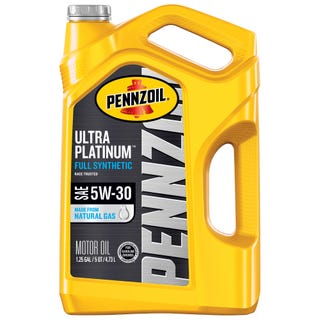When Should You Change Your Oil?

You know you need to change your car’s oil at some point, but how often? The answer can be confusing, because it varies based on driving conditions and your driving habits. Let us simplify it for you.
Conservative estimates for oil-change intervals used to be as low as 3000 miles, before significant improvements in fuel-delivery systems, engine materials, manufacturing methods, and oil chemistry. Today, modern engines driven normally stretch intervals to 7500 or even more than 10,000 miles. So what’s the right answer?
When Your Vehicle Is in Warranty
When a vehicle is new, the answer is simple: If you don’t want to void your powertrain warranty, follow the oil type, mileage, and time recommendations in the owner’s manual. (Lost your owner’s manual? It’s likely available online.) In most cases, you’ll be taking your vehicle to the dealer for required inspections and maintenance, and oil changes will be included in that regime.
Getty Images
Some newer vehicles have a built-in oil-life monitor. This gadget uses an algorithm, sensors, and software that keep track of drive temperatures, cold starts, driving hours, idling hours, and engine revs. It uses that data to calculate the oil’s condition and warranty-preserving change intervals. Keep in mind that the oil monitor is calibrated for the oil type recommended in the owner’s manual. Service alerts are displayed in the instrument cluster. In some systems, one of the instrument-cluster information screens will read out remaining oil life as a percentage. This is much different from the red oil-pressure warning light that glows when you start the engine. If that’s on while you’re driving or idling, it means you’re out of oil or have a very serious engine issue. Time to park and key off.
When Your Vehicle Is Out of Warranty
Once you’re outside the maker’s warranty, determining change intervals requires some common sense and an educated guess—unless your vehicle has an aforementioned oil-life monitor. There are often different recommendations for normal and severe driving. Intervals vary widely depending on whom you ask, whether you tow (and how often), the time of year, and even where you drive.
Severe conditions include:
If you make many short trips of five miles or less (in normal temperatures) If you make many short trips of 10 miles or less (in freezing temperatures)Extreme hot-weather stop-and-go driving Driving at low speeds for long distances Lots of miles on dusty, muddy, salty, sandy, or gravel roads Long-distance trailer towing Track driving

Getty Images
Are Frequent Oil Changes Better?
Not surprisingly, service providers (oil-change shops and dealerships) tend to recommend shorter change intervals (3000 to 5000 miles). That can never hurt your engine, but it also means they’ll see you and your credit card more often. When your car’s on the lift for an oil change, other wear items such as brake pads, coolant, tires, and shocks can also be assessed and possibly replaced. So it’s also obviously good for their business. (With older vehicles, which may burn oil, you’ll want to check the oil level using the dipstick at least once a month.) But if you’re not driving your car in severe conditions—and few of us are—you can stick to the manufacturer’s recommended oil-change intervals (which often include an oil-filter change at the same time). And, of course, if your car has an oil-life monitor, heed that.
Longer-Life Oils
What about using premium extended-life and pricey synthetic oils for projected 10,000- and even 12,000-mile changes? About synthetics: Almost all newer vehicles use synthetic oil, so if the manufacturer specifies that, you must use it. Many older vehicles weren’t filled with synthetics when new and still use conventional petroleum-based oil. In that case, you have a choice.
Some oil refiners produce sophisticated carmaker-approved extended-life oils that do help stretch the time between changes. These oils have special chemistry or additives that support their ability to go longer distances. They resist high-temperature breakdown better and keep dirt and particulates in suspension longer so that the oil filter can catch them. They also cost more than standard oils; you’ll need to do the math to see if it’s worth the extra cost.

Getty Images
A Few Words of Caution
If you operate on dirt roads or in dusty or road-salted environments and do lots of cold starts and short runs, the factory oil filter has only so much scrubbing capacity. (That’s why most makers recommend replacing the filter at each oil change.) Further, the longer-range oils can become contaminated by the sheer volume of combustion gases that blow past the worn piston rings of older cars. At some point, the oil is no longer protecting the sliding surfaces within the engine as well as it should. Engine wear accelerates after the oil breaks down or is highly contaminated. And finally, almost no automaker recommends that oil should be left in the crankcase for more than one year—no matter the mileage.
Recycling Oil
If you’re changing your own oil, be sure to recycle properly. Most auto-parts stores (check before you buy) and oil-change businesses will take back used oil at no charge. Whether you do it yourself or have it done for you, changing your oil at the proper intervals will make your engine last longer and run better.
FAQs
How often should you change your oil in months?
It depends on the manufacturer. The old-school way was every three months, but with improvements to oil quality and engine materials, that interval can be pushed to anywhere between six and 12 months. Your owner’s manual will detail the interval.
What happens if you go too long without an oil change?
As your oil quality wears down, so do the components it’s supposed to protect. If you go excessively long between oil changes, you’ll reach the point of no return, and your vehicle’s engine will become a massive repair bill, or even total failure.
Can I change oil every two years?
No. Almost no automaker recommends that oil should be left in the crankcase for more than one year—no matter the mileage.
How do I know when my oil needs changing?
Typically, follow the mileage and time intervals listed by your vehicle’s manufacturer. But this can vary, depending on the severity of your driving. As detailed above, shorter trips, track time, and dusty roads can cause your oil to break down faster and need to be changed earlier.
Some vehicles have instrument-cluster information screens that will read out remaining oil life as a percentage. If you don’t have this feature, follow along with the sticker from the oil-change place or keep track of mileage on your own. Don’t forget to check your oil via the dipstick at least once a month.
Gear Up for an Oil Change with These Products

Full Synthetic 5W-30 Motor Oil
Full synthetic
Widely used
May not be the correct oil for your vehicle

Full Synthetic Motor Oil 0W-40
Fully synthetic
Trusted brand
May not be the right oil for your vehicle

Spin-On Oil Filter
Optimized for synthetic oil
Fram claims protection for 20,000 miles
Might not fit your vehicle

Extended Performance Oil Filter
Heavy-duty
20,000 mile guarantee
Only compatible with certain vehicles

Brakleen
Cleans oil residue
Can be used to clean other components
Try not to breathe this stuff in

Funnel set
Prevent oil spills when refilling engine
Different sizes

15-Quart Drain Pan and Waste Oil Storage
Collects and stores old oil
Strainer to catch drain plug

Heavyweight Absorbent Mat
Great for absorbing small spills
Easily tears off roll
Proper disposal varies by state
This content is created and maintained by a third party, and imported onto this page to help users provide their email addresses. You may be able to find more information about this and similar content at piano.io



